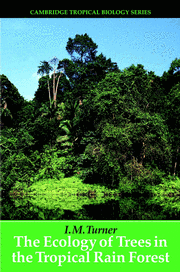1 - Introduction
Published online by Cambridge University Press: 24 November 2009
Summary
The tropical rain forest
Tropical rain forest is one of the major vegetation types of the globe (Richards 1996; Whitmore 1998). It is an essentially equatorial and strongly hygrophilous biome as its name suggests and is found on all the continents that the tropics touch. Tropical rain forest is defined physiognomically with typical features being a closed, evergreen canopy of 25m or more in height dominated by mesophyll-sized leaves, with an abundance of thick-stemmed woody climbers and both herbaceous and woody epiphytes. Altitude has a marked effect on forest physiognomy above about 1500m, and montane facies have to be distinguished. The so-called tropical diurnal climate has a temperature regime in which the major periodicity is the daily march from night-time lows to afternoon highs. The fluctuation through the year in mean monthly temperatures is usually of smaller magnitude than the typical daily temperature range. Temperatures usually average at around 27°C at lowland weather stations in tropical rain-forest regions, and minima rarely, if ever, enter the chilling range below 10°C. Rainfall is generally at least 2000mm per annum, and a month with less than 100mm is considered dry. Rain forests can withstand dry periods though prolonged, or particularly severe, droughts on a regular basis usually lead to drought-deciduous forest replacing the true rain forest. Many rain forests do persist despite annual dry seasons, though only if the trees have access to ground water in areas experiencing long periods without rain.
- Type
- Chapter
- Information
- The Ecology of Trees in the Tropical Rain Forest , pp. 1 - 14Publisher: Cambridge University PressPrint publication year: 2001

